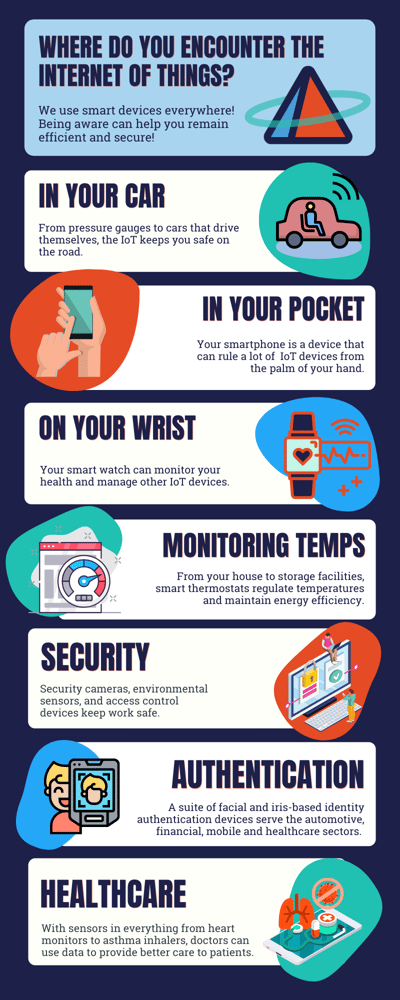The Internet of Things (IoT) describes the network of physical objects that contain sensors and software for the purpose of exchanging data with other devices or systems over the internet.
What is the Internet of Things?
The IoT is a system of interrelated devices that communicate with each other without requiring human-to-human or human-to computer interaction.
The first discussion regarding the IoT was in 1982, when Coca-Cola came out with a vending machine at Carnegie University that was able to report its inventory and whether the drinks were cold or not. A pretty novel idea back in the day.
Fast forward to today and you can find devices everywhere from items in a smart home—appliances, toilets, medical and healthcare (Internet of Medical Things IoMT), pacemakers and biometric devices. It’s hard not to find examples as they are so commonplace and we tend to take them for granted whether driving a car, tracking our fitness progress, reading email off a smartwatch or watching the latest TikTok fad.
Take a moment and think where our lives would be today without these amazing devices.
How does the IoT work?
Basically, these devices gather information from their environment whether it’s the temperature of a patient, road conditions, or connected footballs that track how far and fast they are thrown. They can take this information and decide which is useful and discard the rest, while transmitting this information to the cloud.
Once data reaches the cloud this information is processed by software and then made useful to the user in some way. Whether it's an alert with a text notification, or a reminder you need to take more steps in your day.
Real world examples of the IoT at work and at home
Since I’m in the tech industry, I tend to look at IoT devices from a security perspective and actually limit the number of devices I use both in my personal life and work. For my personal life I have a Nest thermostat so that I can remotely monitor the temperature of my home and my smartphone. That is it. The Nest thermostat can even discern when the house is empty and adjust the temperature to a more energy efficient rate which I can then later adjust before leaving work so that my house is a comfortable temperature when I walk in the door.
In our work we tend to use them more for monitoring temperatures of client server rooms.
Why is IoT important?
The internet of things helps us work and live more efficiently, embodying the old adage, “Work smarter, not harder”. At home it can be fairly simple to see how IoT helps. I have a co-worker whose children tell their Alexas when they are out of snacks which then feeds a list that populates in her grocery shopping cart so that they are never out of Cosmic Brownies. At work, the IoT provides organizations with a real-time look into systems, allowing us to gain insight into everything from machine performance to larger scale systems like supply chains and logistics.
These automated processes can reduce labor costs, waste, improve delivery and customer service, making it less expensive as well as providing transparency into operations and customer transactions.
Generally speaking, IoT is most abundant in manufacturing, transportation and utility organizations as they make use of sensors and other IoT devices. The ability to monitor operations with sensors also provides those working in infrastructure many opportunities to monitor weather, traffic, events, and even changes within structural buildings or bridges. In the healthcare setting, hospitals can use IoT systems to manage inventory of pharmaceuticals and medical instruments. Doctors can use data collected from patients’ phones and smart watches to see everything from steps walked, calories consumed, blood sugar and heart rate. These uses provide benefits such as cost-savings, saved time, paperless workflows, quality-of-life, and in some instances, can save lives!
Pros and Cons of IoT
Advantages of IoT
- Easy access to information from anywhere at anytime on any device
- Improved communication between electronic devices
- Saves time and money transferring data over a connected network
- Automating tasks to improve services and reduce the need for human intervention
Disadvantages of IoT
- As the number of connected devices increases, so do the entry points for hackers to gain access to information
- Enterprises may have to deal with massive numbers of connected sensors and devices and that amount of data can be difficult to process.
- If there is a bug in the system, it can corrupt all connected devices
IoT’s have come a long way from their humble beginnings since 1982 and will continue to grow as we find more useful ways in which to interact with them. New devices are created all the time and it’s interesting to see where they will lead us in the future.